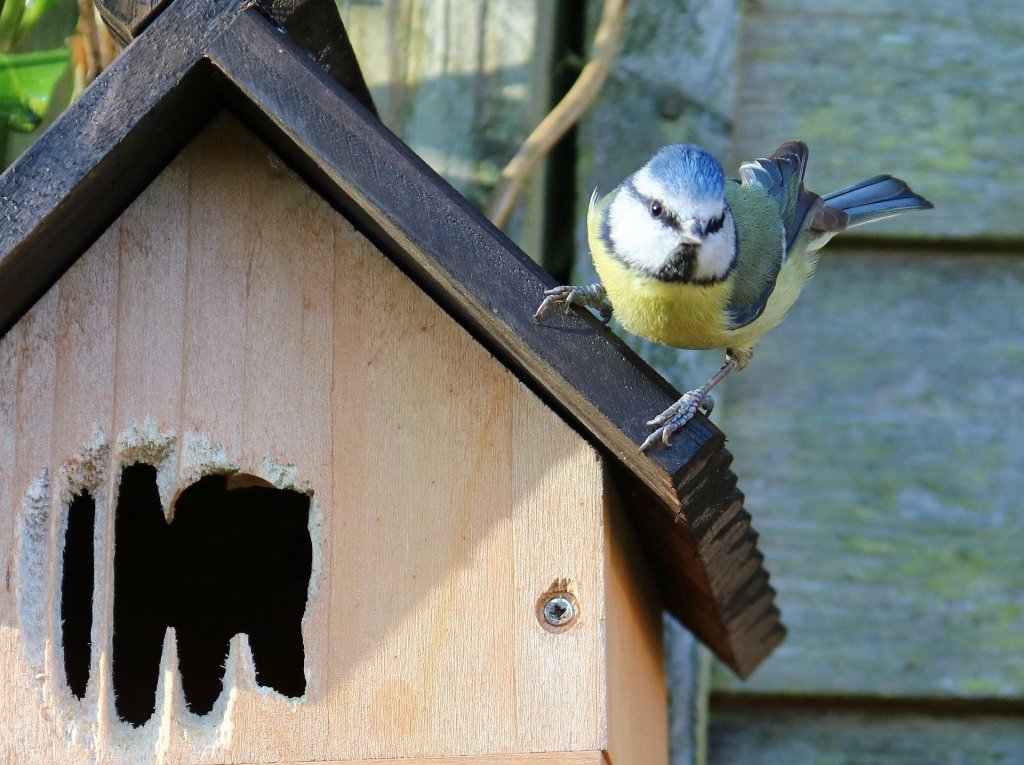
We’ve had a bird box for several years. It was a housewarming gift from a friend. There it sat, an A-frame wooden box with a tiny porthole in the front so small we couldn’t imagine any creature getting in there, let alone getting out. So it became an adornment, a pretty fixture without function, until this year when we discovered we had squattters – a couple of blue tits. Neither of us is what you might call an ornithological expert. (There’s a distinction in the bird world between the folks with the binoculars – bird-spotters who are known as birders, and bird-lovers, more commonly called bird-watchers.). We just about scrape into the latter category.
Like everyone else we’ve become more attuned to the world of our backyard since lockdown, and more aware of birdsong in general since the background hum of traffic was so drastically reduced. But that was as far as our interest went, until the blue tits took up residence.
Slowly but surely, we found ourselves watching the nest activity with as much interest as the latest Netflix box set. Not only did our focus narrow and become more concentrated, but we became proprietorial and protective of the precious cargo in our bird box. We stopped putting out food because it only attracted the bigger birds – pigeons, blackbirds, crows – and we wanted to keep our nest a secret, and safe. We noticed how vigilant the parent tits were, never approaching the nest without first doing a 360 degree scope to check that they weren’t being watched. We found ourselves doing the same.
The blue tits’ presence gave us a stake in the life of the garden which up to this had been about plant care and control. Overnight, we became invested in the part of our environment we had no control over.
All through May we watched the frantic activity of the blue tit pair. The female usually lays a clutch of 7-12 eggs which are incubated for up to 16 days, during which time the male will feed the female. After 20 or so days, the birds are hatched. The chicks are born naked and blind and need to be fed continuously involving thousands of foraging trips in and out of the nest. It’s estimated that each chick can eat up to 100 caterpillars a day.
And then the day we were waiting for arrived – when the fledglings left the nest. There were only three of them and we didn’t see them tumbling out of the tiny porthole in the box, but we discovered them on the ground trembling behind our pots, or camouflaged in the branches of plants. They were not much more than three yawning beaks surrounded by a circumference of plump yellow fur on spindly legs. They cried almost soundlessly, opening and closing those beaks with the expectation that mother or father bird might drop a morsel in there. The parent birds duly obliged.
We were looking forward to several weeks of watching them grown and thrive, but the next morning they were gone. We couldn’t believe it. Had they become victims of predators – cats, crows, magpies? (Our one raised bed and our dozen or so pots didn’t provide them with much cover. ) Or had their parents moved them elsewhere to protect them?
The answer is we don’t know. The young can stay with their parents for a few weeks after hatching. But the blue tit mortality rate is very high. Two-thirds of fledglings do not survive their first year. Of a family of 2 adults and 10 young, only one adult and one young bird will typically survive to breed.
Of course, we want to believe “our” blue tits are now fully grown and living independent lives elsewhere but the Covidian stealth of their disappearance suggests otherwise.
It’s fair to say we were bereft. There was something bleak and disowning about looking out into the burgeoning yard and not seeing “our” friends there. The daily ritual involved in hatching and rearing had become an absorbing occupation for us, a show put on for our benefit and to find the place tenantless reduced our yard to backdrop again, rather than habitat. For a while we felt shut out of the secret life of our own garden.
We’ve thought of taking the nesting box down. Could we bear to face the whole rigmarole next year should the blue tits return? For the moment, we’ve left it where it is. After all, this is nature “red in tooth and claw” – to quote Ted Hughes – and now we’ve progressed to being bird-watchers, we know the drill.
Who said knowledge is power?